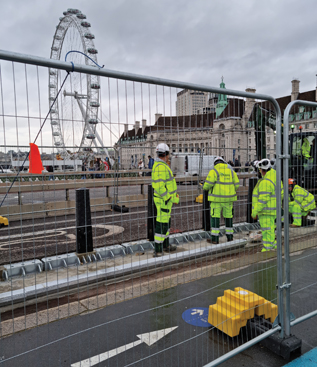The Bataclan-Stade de Paris marauding terror attack of 2015 and the string of terror attacks in the UK in 2017 – rather than the watershed 7-7 suicide bombing of 2005 – have prompted physical security changes to the urban geography of British cities that is still unfinished, writes Mark Rowe.
For historic places such as Canterbury, York and Chester, the adding of bollards to deny the city centre streets to vehicles by day is in a way a reversion to those cities’ Roman origins. Instead of city walls to keep out raiders, those city centres now are restricting vehicular traffic not only in the name of countering ‘vehicle as a weapon’ attacks, but to further a green agenda and make the streetscape safer for cyclists and pedestrians. It so happened that the City of London, the Roman heart of London, had a ‘ring of steel’ in the 1990s to counter the IRA bombing campaign. Then as now, as historically, London has been a target – whether to seek to overthrow political authority (as in the Gunpowder Plot of 1605) or as part of a terror campaign or merely terror for its own sake. An attack is on both the name of London as the centre of British culture, the economy, diplomacy and politics, besides a particular site; it would be wrong to single out examples from so many.
After the 2017 terror attacks on Westminster Bridge in March and London Bridge-Borough Market in June, the inquest into London Bridge heard police witnesses disclaim responsibility for anticipating where terrorists might strike next and mitigating that threat. It also raised the question of who was responsible for London’s bridges – boroughs (as in the case of Hammersmith Bridge, which needs a nine-figure sum to repair it to open it to vehicles) or Transport for London (TfL)? The answer according to highway maintenance works on Westminster Bridge this winter (pictured) is TfL, as its name is on the signage accompanying civils to lay granite paving – Oberon, from the street furniture product company Marshalls – and the HM Government-stamped anti-ram bollards, already a ubiquitous sight along Whitehall and Millbank.
The 2017 terror attacks led to the more or less permanent siting of barriers to protect non-vehicle traffic over London’s bridges. The products however look ugly and some have not worn well either; and on Lambeth Bridge for example are graffitied.
Other physical security changes as a result of the 2017 attack is the extra, chin-height gate at the vehicle entrance to the Houses of Parliament where the Westminster Bridge terrorist entered and murdered a Met Police officer, PC Keith Palmer, before the attacker was shot dead. Like the rest of the ‘Government Security Zone’ Parliament has heavy uniformed policing and the inside of the gate like the rest of the Palace of Westminster routinely has armed police. Meanwhile also routinely on foot patrol are red-tabbed ‘heritage wardens’, under a contract by TfL for the Greater London Authority (GLA) covering ‘national heritage assets’ on Trafalgar Square and Parliament Square Garden.
See also ‘City centre anti-terror planning‘.
Photo by Mark Rowe; Conway contractors at work on Westminster Bridge yesterday afternoon.










